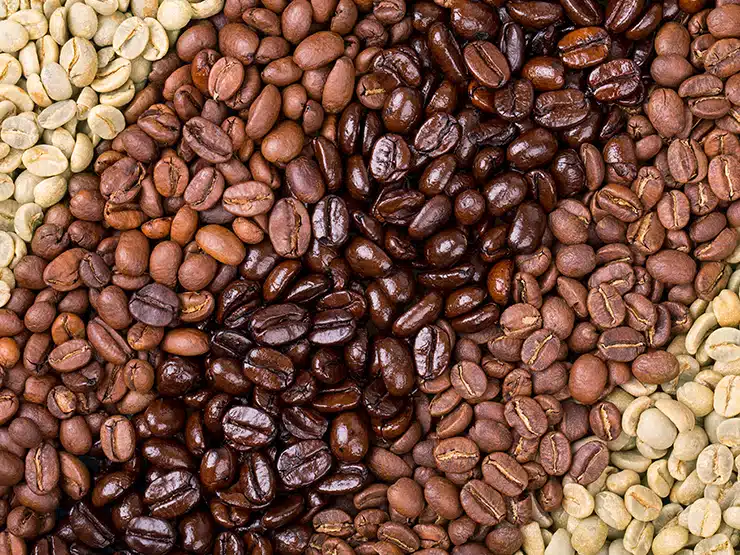
If you’ve ever found yourself overwhelmed by the sheer amount of options when it comes to choosing which type of coffee best suits your needs, you’re not alone. With so many different kinds of varieties, it can be difficult knowing where to even begin! One of the main factors you should consider when shopping for coffee beans is the roast level.
There are four different types of coffee roasts: light, medium, medium-dark, and dark. Each type of roast presents a number of unique characteristics that can affect the body, aroma, and flavor of your cup of coffee. If you’re curious in learning about the differences in coffee roasts, we’ve included all of the info you need to know to make an informed purchasing decision.
Before we dive into the different types of coffee roasts, let’s first learn a bit more about the roasting process itself!
How Is Coffee Roasted?
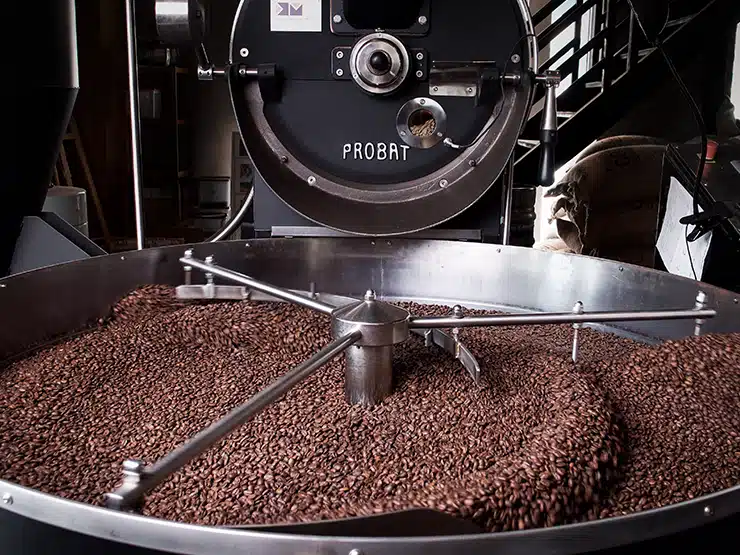
Before coffee beans are ready to be enjoyed by consumers, they’re first placed into a loader that feeds into a hot rotating drum. Typically, raw coffee beans are roasted from 356°F to 482°F, and the rotating drum plays a large role in maintaining these desired temperatures. The master roaster then adjusts the rotating drum’s speed to precisely expose the coffee beans to the proper amount of direct heat. Too little heat and the beans will taste sour, while too much heat produces a bitter or burnt taste.
Roasting one batch of coffee can take between 10 to 15 minutes, depending on the batch size. Once the roasting process has finished, the coffee beans are released onto a cooling tray and sit for around one to two weeks. During the roasting process, coffee beans build up gasses that are released in the form of CO2. Allowing the beans to degas over an extended period of time before packaging them produces a more natural-tasting finished product.
What Are the 4 Different Types of Coffee Roasts?
Light Roast Coffee
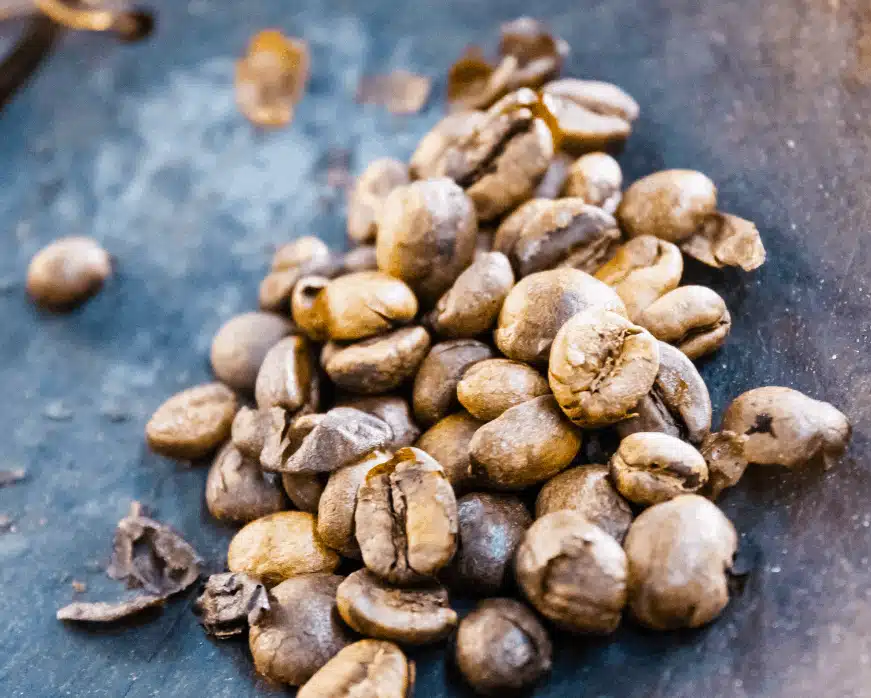
Have you ever wondered which coffee roast is least bitter? As its name suggests, light roast coffee beans are roasted the shortest amount of time at the lowest temperature, typically 356°F to 401°F. The end result is a coffee bean that appears light in color with little to no visible oils. Light roast coffee possesses a mellow body with bright tasting notes when compared to other roasts. This makes it a perfect option for beginners or coffee enthusiasts that prefer a milder brew.
To achieve the best brewing results from light roast coffee beans, it’s recommended that the beans are finely ground to ensure proper extraction, as this increases the overall surface area of the grind resulting in more developed flavors.
Light Roast Flavor Profiles
- Bright
- Lightly Acidic
- Fruity
- Crisp
- Sweet
One of the best methods for brewing light roast coffee is by using a pour over. The pour over brewing method has been around since 1908, and has remained as one of the best options for bringing your coffee beans’ flavors to life. Some of the most popular pour-over coffee makers are the Chemex, Hario V60, and OXO Brew Single.
Additionally, French presses like the Bodum Chambord, Aeropress, or double-insulated Mueller work very well with light roasts. Both pour over coffee makers and French press allow you a greater range of control so that you can brew the perfect cup of coffee every time.
Popular Light Roast Coffee Beans
Ethiopian
Often referred to as the birthplace of coffee, Ethiopia’s coffee forests date back centuries. Similarly to other light roast coffee, Ethiopian coffee beans bring forth floral and fruity flavors that are both mild and pleasant. With a medium to high acidity, these beans have a sweet and crisp finish that pairs nicely with breakfast pastries and desserts.
Costa Rican
With moderate acidity and a sweet, fruity flavor profile, Costa Rican coffee is a popular choice for individuals that prefer a lighter roast. Costa Rican coffee beans are grown in an area of the world that experiences both higher altitudes and heavy rainfall, creating an ideal climate for coffee growers.
Colombian
Colombian beans require minimal roasting to bring out their full tasting notes. With a flavor profile that features hints of floral, nutty, chocolaty, and citrusy notes, Colombian coffee has reserved its place as one of the most popular types of coffee in the world. These beans grow on steep slopes in a tropical climate, allowing them to thrive in a perfect environment.
Medium Roast Coffee
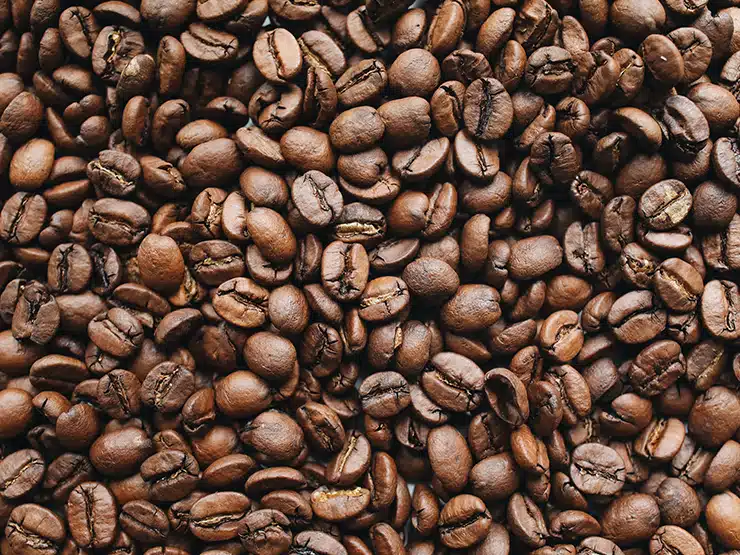
A step up from light roast coffee, medium roast coffee is roasted for a slightly longer period of time with internal temperatures reaching 410°F to 428°F. This results in the bean having a darker color and greater amount of visible oils. Medium roast coffee has a glossy sheen with a balanced body and acidity level. As a middle-of-the-road roast, it’s one of the most popular and widely available options available to coffee lovers.
When brewing medium roast coffee, it’s best to use a medium grind that will allow for proper extraction. Using too fine of a grind for medium roast beans will cause your coffee to taste bitter, effectively preventing you from experiencing all of the delicious flavors this type of coffee has to offer.
Medium Roast Flavor Profiles
- Balanced
- Less Acidic
- Sweet
- Caramel
- Chocolate
Popular Medium Roast Coffee Beans
Guatemalan
Coffee beans that are grown in Guatemala tend to have a flavor profile featuring hints of nuttiness and chocolate, as well as sweeter floral notes. This balanced coffee bean has a smooth finish making it an easy brew to sip throughout the day. Grown in an area with elevation levels reaching 5,000 feet above sea level, and paired with mild temperatures year round, Guatemala is one of the best locations for coffee plants to flourish.
Brazilian
As the largest supplier of coffee in the world, Brazil produces upwards of 43 million bags of coffee each year. Medium roast Brazilian coffee beans bring forth delectable flavors of caramel and chocolate, as well as nutty aromas. If you prefer a coffee that is low in acidity, then you can’t go wrong with a Brazilian roast.
Kenyan
Grown in rich volcanic soil, Kenyan coffee beans are packed with bright, fruity flavors such as lemon and blackberry, and offer up a crisp finish attributed to its uniquely high acidity content. With a full body and one-of-a-kind flavor profile, paired with the country’s unique altitude and soil conditions, Kenyan coffee is sought after by coffee enthusiasts around the globe.
Medium-Dark Roast Coffee

A fine balance between medium and dark roast coffee beans, medium-dark roasts reach internal temperatures of 437°F to 446°F, causing these beans to appear darker and oilier than light or medium roasts. If you prefer coffee that is characterized as being full-bodied and rich, then medium-dark roast beans are an excellent choice.
Since this type of roast tends to have a bolder profile, it’s recommended that a medium-coarse grind is used to experience its full range of flavors. If too fine of a grind is used while brewing medium-dark roast coffee, the water will not be able to flow through the coffee grounds as well, resulting in an overly bitter cup of coffee.
Medium Roast Flavor Profiles
- Nutty
- Chocolate
- Smoky
- Caramel
- Slightly Bitter
Although any kind of coffee maker can be used for any given roast, medium-dark roast beans stand out when using espresso machines such as the De’Longhi Stilosa, Breville Barista Express, or Mr. Coffee Espresso maker. If you’re interested in a more simplified way of brewing coffee, consider a standard drip coffee maker from household brands like Cuisinart, Ninja, or Capresso.
Dark Roast Coffee
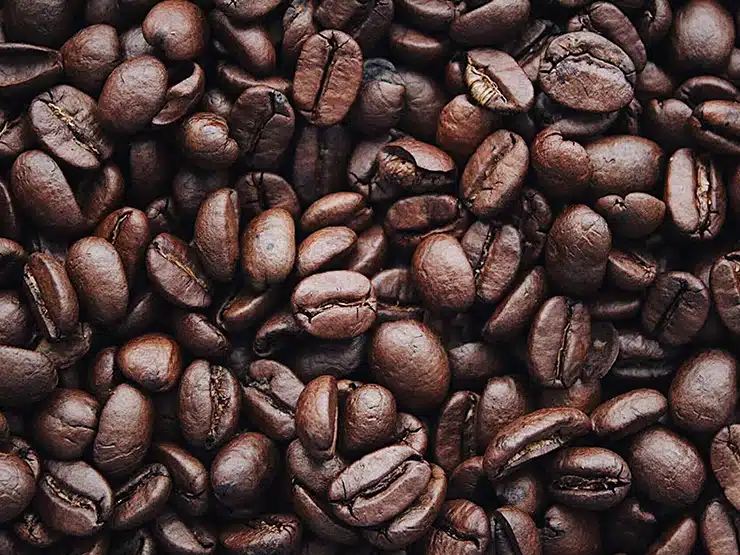
Roasted for the longest period of time and reaching internal temperatures of 464°F to 482°F, dark roast coffee beans present a deep-brown color with a surface that’s packed full of shiny oils. This roast tends to be the strongest with a full body and low acidity that is sure to please. Given its robust flavor profile, dark roast coffee is commonly enjoyed alongside desserts as the two complement each other rather well.
To get the most out of your dark roast coffee beans, consider using a coarse grind. Doing so will ensure that your water is able to properly extract all of the flavors from your coffee beans without causing it to become too strong to drink.
Dark Roast Flavor Profiles
- Molasses
- Dark Chocolate
- Robust
- Toasted
- Smoky
- Maple Syrup
Popular Dark Roast Coffee Beans
Sumatran Mandheling
With a low acidity and bold full-body profile, Sumatran Mandheling coffee is one of the most popular specialty coffees in the world. Sumatran coffee offers delicious flavors of chocolate and tobacco, with earthy undertones and notes of spiciness. Given its robust qualities, Sumatran coffee pairs extremely well with delicate, creamy desserts like crème brûlée or cheesecake.
Italian Roast
If you like intensely bold coffee, Italian roasts are one of the strongest roasts available. In fact, Italian roast coffee is roasted longer than most dark roasts, giving it bittersweet flavors with slightly charred undertones. While Italian roast is typically not preferred for traditional coffee brewing methods, it is often one of the favorite choices when brewing espresso shots.
French Roast
Originating from Europe in the 1800s, French roast coffee beans are another popular choice for coffee drinkers that enjoy a more robust brew. Similarly to Italian roast beans, French Roast coffee features hints of smokiness with a subtle sweetness that can be appreciated using a drip-brew coffee maker or French press.
Vienna Roast
While French roast and Italian roast beans tend to have smokier flavor profiles, Vienna coffee beans are able to retain more of the natural flavors associated with coffee without carrying the same smokiness. Additionally, Viennese coffee is commonly served with melted chocolate, whipped cream, and sometimes milk to balance out its robust characteristics.
Myths About Coffee Roasts
Myth #1: Dark roast coffee has more caffeine than light roast coffee
One of the most popular myths surrounding coffee is that one type of roast contains more caffeine than another. Some individuals believe that light roast coffee has more caffeine than dark roast coffee, while others tend to believe the opposite to be true. The truth is that caffeine levels are not determined at all by roast levels, or how strong your cup of coffee tastes.
Instead, caffeine content in coffee is typically influenced by the variety or species of the coffee plant from which the beans were harvested. Robusta beans, for example, have twice as much caffeine content as Arabica beans, making them a popular choice for individuals that are wanting to jump start their morning with a jolt of caffeine.
Myth #2: Dark roast coffee beans are more acidic than light roast coffee beans
If you’ve ever wondered what coffee roast is best for the stomach, you can’t go wrong with a dark roast. A common misconception is that dark roast coffee is more acidic than light roast coffee. In reality, the opposite tends to be true. In fact, dark roast coffee is known as one of the most stomach-friendly types of coffee thanks to it containing higher levels of N-methylpyridium compared to other roasts. N-methylpyridium helps slow down your stomach from producing hydrochloric acid while drinking coffee which can cause heartburn, acid reflux, and other unwanted side effects.
Myth #3: Light roast coffee is better than dark roast coffee
Some individuals hold the belief that dark roast coffee beans are burnt and of lesser quality than light roast coffee beans. However, many dark roast coffees are full of rich, chocolaty flavors and possess no burnt tasting notes. Oftentimes, the burnt taste individuals associate with dark roast coffee is simply due to the fact that the beans were brewed incorrectly, leading to an overpowering taste that eliminates the nuanced flavor profile dark roast beans offer.
Coffee Roasting: Final Thoughts
We hope you enjoyed learning about the 4 different types of coffee roasts and their flavor profiles, how coffee beans are roasted, and how the regions where beans are grown and harvested can significantly impact the finished product. Overall, the best way to determine what coffee roast is right for you is by simply experimenting with different types of beans to see which flavors you like most. Making better coffee at home starts with choosing the right type of coffee roast, so don’t be shy to try something new!









